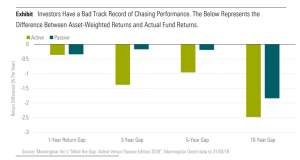Staying the Course Versus Timing the Market (est read time: 6 mins)
Kyle Cox, Investment Analyst, EMEA
Dan Kemp, Chief Investment Officer, EMEA
Key Takeaways
- As the old saying goes, time in the market is generally superior to timing the market. Yet, investors
tend to have a bad habit of buying winners too late and dumping losers too soon. - Staying the course does not necessarily mean sitting still. It means avoiding bad behaviour,
remembering your goal and ensuring you approach markets with discipline.
“Stay the course” is a nautical phrase that has been popularised by world leaders, primarily in the
context of battle, according to Wikipedia. According to Stewart Alsop’s 1973 memoirs of a conversation
with Winston Churchill, the British prime minister contemplated towards the end of World War II:
“America, it is a great and strong country, like a workhorse pulling the rest of the world out of despond
and despair. But will it stay the course?”1
We ask the same question today of investors, after what has been an emotive period for financial
markets. From trade wars to Brexit, North Korean tensions to Italian political turmoil, we’ve had plenty of
noise to deal with. So, what do we mean by “staying the course”? It is not always about sitting still
(even though this is often the easiest path to investing success), but rather, to focus on the goal that you
set in the first place and ensure your behaviour aligns with it.
Let’s face it, investors too often redirect their focus from the destination to the journey. Much like in
other walks of life, we can lose focus, making us susceptible to capitulation or giving up at the exact
moments when we require fortitude and resolve. That is, investors are hard-wired to be procyclical,
chasing the winners and selling out of the losers because of a yearning to make money work harder for
us. This is not just conceptual, we can see it directly in the fund flow numbers.

Therefore, it is vital that as investors we remain vigilantly aware of how animal spirits can drive irrational
decision-making, and that we adopt a reasoned framework for investing. Behavioural errors can wreak
havoc on long-term portfolio returns due to excessive and unjustified turnover.
A Step-by-Step Guide to Staying the Course
The best thing an investor can do when contemplating change is to reflect on their goals. Would the
investment change align with the original investment plan or strategy for reaching well-defined goals?
The key question to ask is whether anything has fundamentally changed since setting the original
strategy or whether it’s just that the client is disappointed with the progress towards goals.
- If something has fundamentally changed, the next question to ask is whether you can clearly
identify what has changed. Write it down, then balance this by writing what it might mean if
you’re wrong. This should include any misjudgment risk as well as the added costs if you
decided to change investments. You will often find that the change you desire is not
necessarily going to increase the probability of reaching your goal/s. - If it has “just” disappointed you, but nothing has fundamentally changed, the likely best
option is to stay the course. By thinking probabilistically and remembering that investment
markets never move in straight lines, you may avoid the perils of trying to time the market.
Furthermore, you may benefit by doing the opposite to your intuition (given the evidence
against it) and teach yourself to be a contrarian.
How We Think about Staying the Course
As professional, multi-asset investors, we focus on the investment objective, always bearing in mind the
opportunity costs and risks. We also write down a balanced thesis that ensures we remove any emotion
from our decision-making.
In this sense, staying the course is not idle or passive, but rather about staying aware. Some investors
may look at a recent period of lean returns and, with a hindsight bias and the herd mentality at play, will
fear for the future. Many will further justify to themselves that reward for risk is simply not sufficient
and will consider a change in strategy. This thinking is usually well intentioned, but it is dangerous and
must be thought through with a long-term perspective.
Staying the Course vs. Timing the Market
Investing, like many things, often involves taking the thorns with the roses. Over dozens of years and
through all investment literature there is one golden thread–the evidence clearly favours time in the
market over timing the market.
This can be illustrated in various ways, but one of the most compelling is to simply reflect on the cost of
missing the best days in the market. We show this below, illustrating how an investor can hamper the
likelihood of reaching their goals by overzealously trying to time the market.
1‘A Stay of Execution’ by Stewart Alsop (1973)





